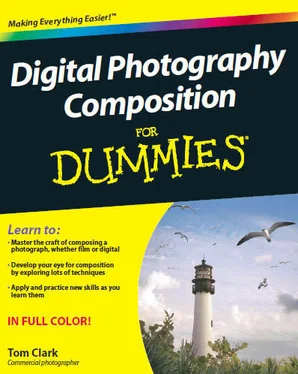1 ...8 9 10 12 13 14 ...81 In an overexposed image, highlights — the brightest areas in the image — are blown out (meaning they provided more light to the sensor than was necessary and the sensor recorded them as white) and lack detail. In an underexposed image, shadow areas are dense (meaning they didn't provide enough light to the sensor and appear to blend together in a dark matter) and lack detail. The best exposure for a scene is one that maintains detail in the highlights without underexposing the shadow areas.
In the following sections, I walk you through the information you need to achieve great exposure for your images. I start off with the basics on aperture, shutter speed, and ISO, and then I move on and show you how to use histograms and light meters to determine exposure.
Taking a closer took at aperture, shutter speed, and ISO
Your camera's digital sensor exposes images based on the following factors:
Aperture:The lens's opening, which you can widen to let in more light or close down to limit the amount of light
Shutter speed:The length of time a camera's shutter is open, which determines the length of an exposure
ISO:The sensitivity level that your digital sensor has to light
Understanding how each of these settings works individually and how they work together maximizes your control over any composition. Even though these factors help control your exposure, each controls other specific aspects of your images as well. So by comprehending what each one is used for, you gain the ability to selectively manipulate your exposure while maintaining control of the other effects that are vital to your message.
Aperture, shutter speed, and ISO are represented in stops — units of light used to measure and control exposure. If you increase your exposure by 1 stop, you're brightening your image and the information on your histogram shifts to the right uniformly in the amount of 1 stop. (Refer to the later section "Using a histogram to check exposure" for more on how a histogram can help you.)
The typical range (ability to capture detail) of a digital sensor is about 6 to 8 stops from black to white. Properly exposing a picture of a gray wall produces an image in which the wall appears gray. If you overexpose a gray wall by 3 stops, it appears white. If you underexpose it by 3 stops, it appears black.
I delve into more detail about aperture, shutter speed, and ISO in the following sections.
Controlling tight With your aperture
Your camera's aperture controls your exposure by determining how much light enters the lens during a given exposure. You set your aperture first when the depth of field (the area of a scene that appears sharp in an image) in your scene is important to your message. Then you can adjust the shutter speed and ISO according to your chosen aperture to get the exposure you're looking for in your image. (For more on depth of field, head to Chapter 7.)
A number known as an f-stop signifies what aperture setting you're using. The higher the number is, the smaller your aperture is and the less light it lets in. Figure 3–2 shows aperture values in 1-stop increments. Each f-stop is roughly
50 percent greater than the one before it. The value doubles every 2 stops. If your camera is set to f/8 and you want to increase your exposure by 1 stop, open the aperture to f/5.6.
In addition to exposure, Figure 3–2: Aperture values in 1-stop increments. aperture also controls
your depth of field. A wider aperture produces a shallow depth of field, meaning that less of your image is sharp. A smaller aperture produces more depth of field and shows a greater area of the scene in focus. Setting your aperture to f/5.6 gives you a somewhat shallow depth of field, and shooting at f/2.8 gives you a very shallow depth of field. An f-stop of f/8 gets you closer to a great depth of field, and f/22 is usually good enough to make a whole landscape appear sharp.
Figure 3–3 shows a scene photographed at two different apertures (but otherwise exposed the same). I shot the image on the left with an aperture of f/2. The subject stands out because the background is blurry and the image has an overall softer feeling than the one on the right. I photographed the image on the right at f/16, giving sharp detail throughout the scene and drawing more attention to the background and away from the subject itself.
50mm, 1/8 sec, f/2, 100 50mm, 1/8 sec, VIS, 100
Figure 3–3:Two images exposed the same but taken with different apertures.
Setting your shutter speed
Your shutter is a curtain that sits in front of the digital sensor. When it's closed, no light enters your camera. When the shutter opens, the digital sensor is exposed to light. The shutter speed controls the length of an exposure by determining how long the shutter remains open: The slower the shutter speed, the longer the exposure. For normal, sunny-day shooting, shutter speeds typically are measured in fractions of a second, such as 1/125 or 1/60.
When you slow down your shutter speed by 50 percent (from 1/60 to 1/30), you increase your exposure by 1 stop. If you speed up your shutter speed by 100 percent (1/60 to 1/125), you decrease your exposure by 1 stop. In normal lighting conditions, your shutter speed typically is a fraction of a second. A shutter speed of 1/125 second is a fairly common speed because it's fast enough that you don't get motion blur from the movement of elements in a scene or the shaking of your hand. Motion blur is pleasant in photographs only when used appropriately and for a purpose. (Chapter 16 tells you more about motion blur.)
In low-light situations, you may have to slow down your shutter speed in order to expose an image. If you need to use a shutter speed slower than 1/125 second, place your camera on a tripod to eliminate any camera shake during the exposure.
Shutter speed controls movement in your scene, so setting your exposure with a priority to shutter speed (rather than aperture or ISO) is essential when you need to freeze or reveal motion in an image. Generally, you shoot as fast as possible in order to reveal your subject with as much sharp detail as possible. But you also can reveal motion by using a slow shutter speed (see Chapters 10 and 16 for more information).
Figure 3–4 shows a scene that was photographed using two different shutter speeds. The figure on the left was taken with a fast shutter speed of 1/30, and the figure on the right was taken with a slow shutter speed of 4 seconds. Notice how much movement was captured with the slower shutter speed compared with the faster one.
Adjusting your ISO
The ISO setting on your camera determines how sensitive your digital sensor is to light. The higher the rating, the less time and light you need to achieve a proper exposure. On most digital cameras, the ISO ranges from 50 to 6400. Every time an ISO rating doubles, light sensitivity increases by 1 stop. Here's a list of the ISO ratings to choose from in 1-stop increments: 50, 100, 200, 400, 800, 1600, 3200, 6400.
24mm, 1/30 sec, f/4, BOO 24mm, 4 sac, f/11, 50
Figure 3–4:Changing your shutter speed can have a drastic effect on the way your scene is depicted.
With most digital cameras, you can shoot anywhere with an ISO of 50 to 400 without getting a great deal of digital noise (random speckles of red, green, and blue in an image that appear similar to film grain). Noise usually is undesirable because it makes an image difficult for viewers to read.
ISO settings higher than 400 can cause a photograph to have a noticeable amount of digital noise, so avoid shooting at those settings if you want a smooth quality to your images. The level of noise produced at a given ISO is dependent on your camera. It's a wise choice to do some testing to find out how high you can go before you begin to lose image quality from noise.
Читать дальше
Конец ознакомительного отрывка
Купить книгу












